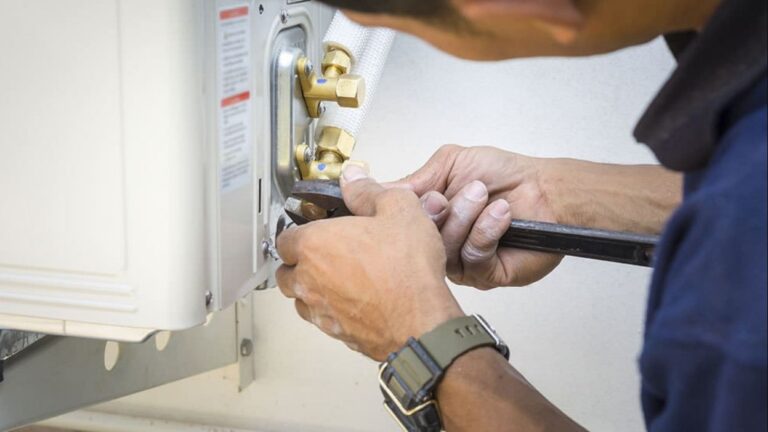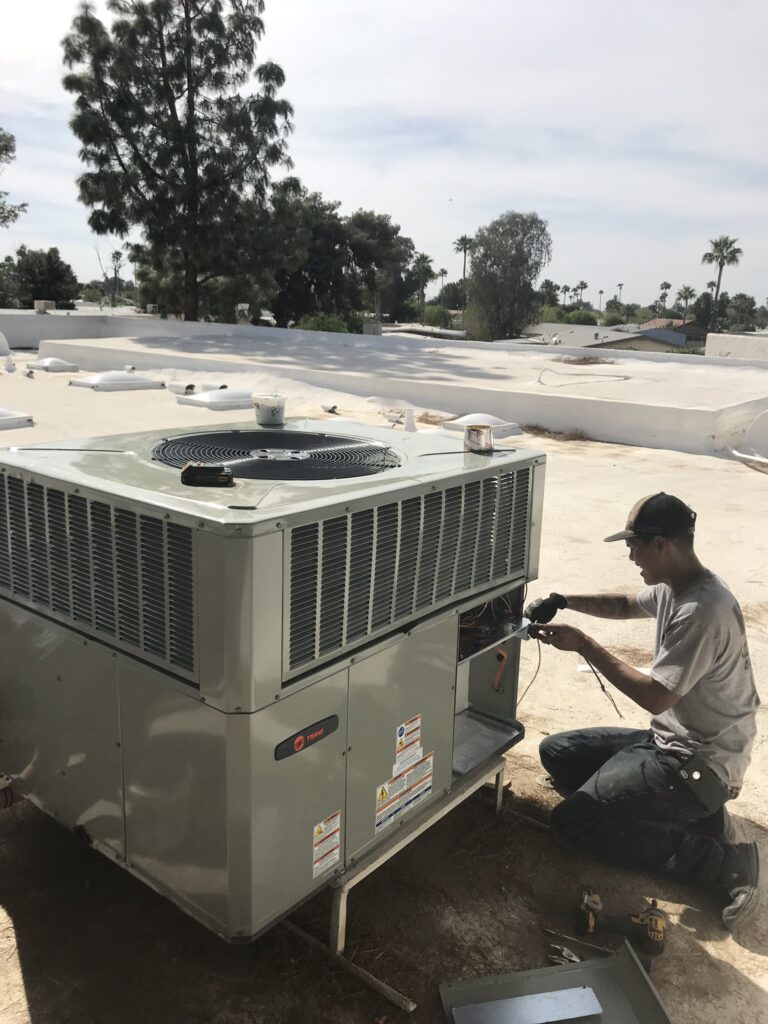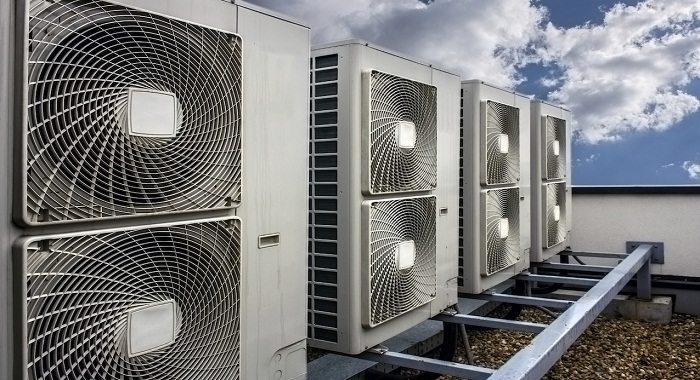What Type of HVAC Air Filter Should You Be Using?
Indoor air quality is a crucial element for any homeowner, especially if members of your household have respiratory problems.
Proper HVAC filters can make the difference between stuffy air filled with pollutants and clean air that’s healthy and easy to breathe.
Understanding the different air filter options for homes is the first step to getting the improved indoor air quality you deserve. Choosing the right filter is crucial for maintaining healthy indoor air quality and protecting your HVAC system from damage. For more information on maintaining your HVAC system, check out our guide on how often to change your HVAC air.
Key Takeaways
- Understand the importance of indoor air quality for your home.
- Learn about the different types of HVAC air filters available.
- Discover how the right air filter can protect your HVAC system.
- Find out how to improve your home’s air quality.
- Make an informed decision about the best air filter for your needs.
Understanding the Importance of HVAC Air Filters
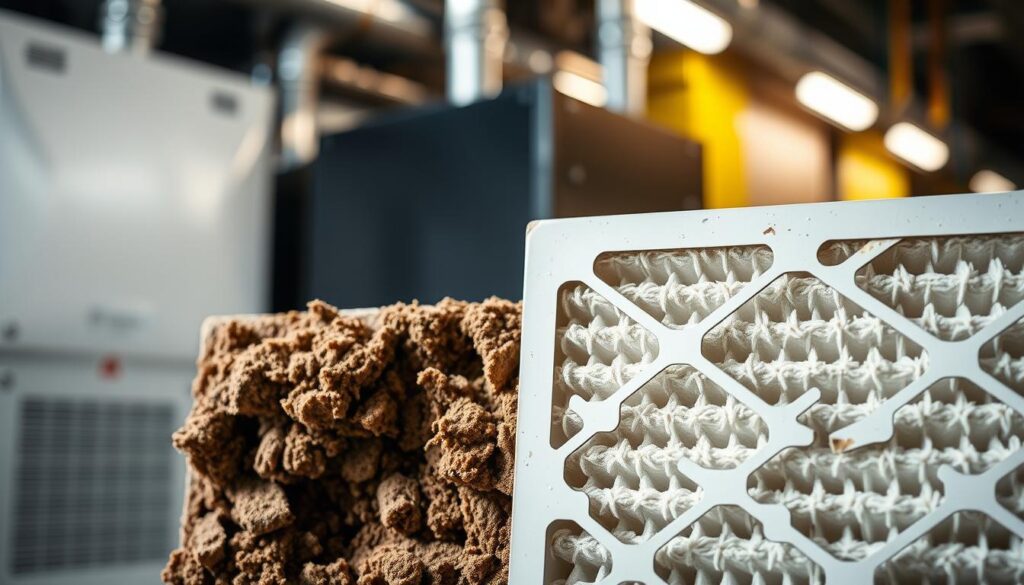
The significance of HVAC air filters cannot be overstated when it comes to maintaining a healthy indoor environment. Your HVAC system’s air filter is designed to capture harmful particles and contaminants, thereby improving indoor air quality and contributing to a healthier living space.
How Air Filters Impact Indoor Air Quality
Air filters play a crucial role in enhancing indoor air quality by trapping particles as air circulates through your HVAC system. This process prevents these particles from being redistributed throughout your home, thereby reducing the risk of respiratory issues and other health problems. In fact, the EPA estimates that indoor air can be 2-5 times more polluted than outside air, making effective filtration crucial.
Common Airborne Contaminants in Your Home
Common airborne contaminants in homes include dust, dirt, smoke, aerosols, odors, viruses, molds, bacteria, and toxic gases. For more information on maintaining your HVAC system and improving indoor air quality, you can visit HVAC maintenance tips for homeowners. These pollutants can exacerbate respiratory issues, skin conditions, and allergies. A comprehensive understanding of these contaminants can be gained by examining the following table:
| Contaminant | Health Impact |
|---|---|
| Dust | Allergies, respiratory issues |
| Mold Spores | Respiratory problems, allergic reactions |
| Pet Dander | Allergies, asthma |
| Volatile Organic Compounds (VOCs) | Respiratory issues, headaches |
The MERV Rating System Explained
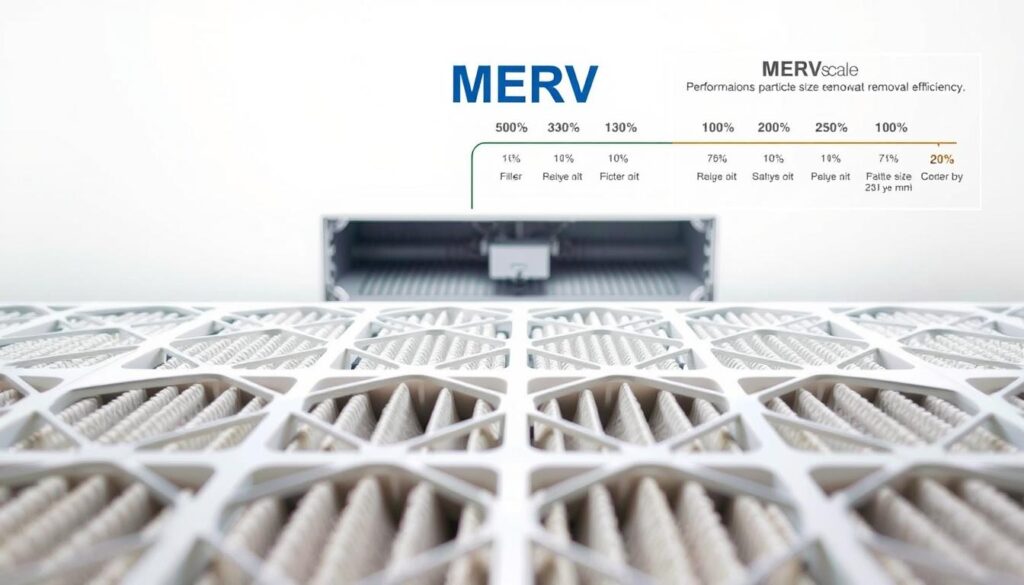
The MERV rating system is a standardized method for measuring the effectiveness of air filters. Developed by the American Society of Heating, Refrigerating, and Air Conditioning Engineers (ASHRAE), this system provides a common language for comparing the performance of different air filters.
What is a MERV Rating?
A MERV rating, or Minimum Efficiency Reporting Value, is a measure of how well an air filter captures particles between 0.3 and 10 microns in size. The rating scale ranges from 1 to 16, with higher numbers indicating better filtration of smaller particles. A higher MERV rating means a filter can trap more and smaller particles, improving indoor air quality.
How MERV Ratings Affect Filtration and Airflow
MERV ratings have a direct impact on both filtration efficiency and airflow. While higher MERV ratings provide better air quality by capturing finer particles, they can also reduce airflow due to the denser filter medium. This can lead to increased energy consumption and strain on the HVAC system. Most residential systems work best with filters in the MERV 8-13 range, balancing good air quality with proper system airflow.
Understanding MERV ratings helps homeowners make informed decisions about their air filters. By choosing a filter with the right MERV rating, you can ensure your HVAC system operates efficiently while maintaining good indoor air quality.
7 Common Air Filter Types for Your HVAC System
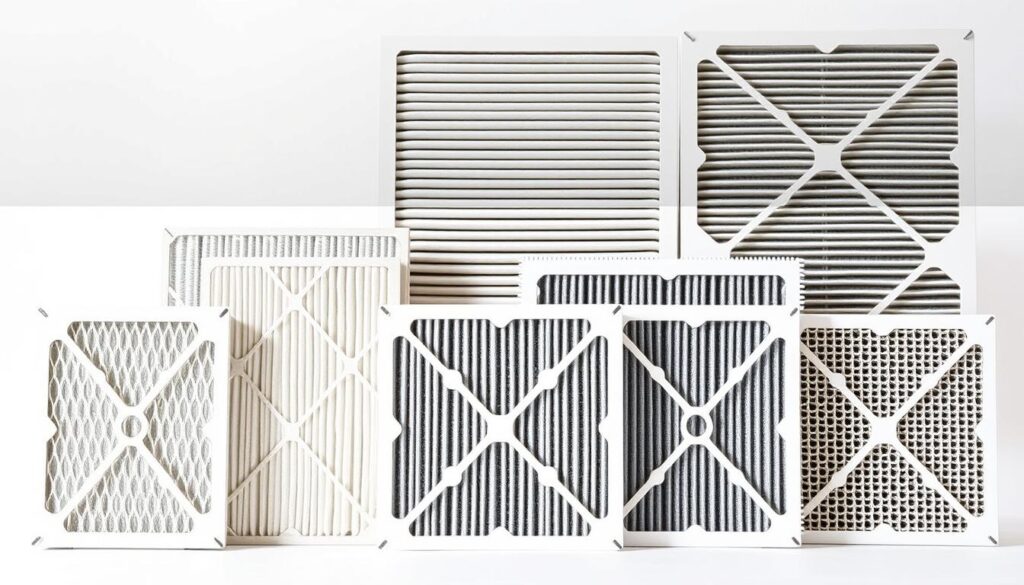
Choosing the appropriate air filter for your heating, ventilation, and air conditioning (HVAC) system is essential for optimal performance and indoor air quality. With various options available, understanding the different types of air filters can help you make an informed decision.
Fiberglass/Spun Glass Filters
Fiberglass or spun glass filters are the most basic and affordable option. They consist of layered fiberglass material that captures larger particles like dust and lint. However, they offer minimal protection against smaller allergens, typically having MERV ratings of 1-4. According to the ASHRAE (American Society of Heating, Refrigerating, and Air-Conditioning Engineers), these filters are effective for basic applications but may not be sufficient for homes with allergy sufferers.
Pleated Filters
Pleated filters feature folded material, usually polyester or cotton, which increases the surface area for particle capture. This design offers better filtration efficiency, with MERV ratings ranging from 5 to 13. They are effective against pet dander, mold spores, and some bacteria, making them a popular choice for many homeowners.
Electrostatic Filters
Electrostatic filters use self-charging fibers that create an electric field to attract and trap particles. Available in both disposable and washable versions, these filters can capture smaller particles that might slip through basic filters. They are a good option for those looking for a more efficient filtration system without the need for frequent replacements.
Washable/Reusable Filters
Washable or reusable filters provide an environmentally friendly option that can be cleaned and reused for up to 5-8 years. However, they require regular maintenance and proper drying to prevent mold growth. Typically, they offer moderate filtration efficiency, making them suitable for homes with average air quality needs.
Media Filters
Media filters are thicker, usually 4-5 inches, with an extended surface area that provides excellent filtration without restricting airflow. They last 6-12 months before replacement and offer MERV ratings of 8-16. These filters are ideal for homeowners seeking a balance between filtration efficiency and airflow.
HEPA Filters
HEPA (High-Efficiency Particulate Air) filters can remove at least 99.97% of airborne particles as small as 0.3 microns. They are ideal for allergy and asthma sufferers, though they may require system modifications due to their density. As noted by the Environmental Protection Agency (EPA), HEPA filters are among the most effective filters available for removing airborne contaminants.
“HEPA filters are considered the gold standard for air purification, capable of capturing an extremely high percentage of airborne particles.”
UV Light Filters
UV light filters use ultraviolet light to kill bacteria, viruses, and mold spores as air passes through the system. Often used in conjunction with other filter types, UV light filters don’t remove particles from the air but can significantly reduce microbial contaminants. They are a valuable addition to HVAC systems, especially in environments requiring high levels of air sterility.
| Filter Type | MERV Rating | Filtration Efficiency | Maintenance |
|---|---|---|---|
| Fiberglass/Spun Glass | 1-4 | Low | Replace frequently |
| Pleated | 5-13 | Moderate to High | Replace every 1-3 months |
| Electrostatic | Varies | High | Replace or wash as needed |
| Washable/Reusable | Varies | Moderate | Wash and reuse up to 5-8 years |
| Media | 8-16 | High | Replace every 6-12 months |
| HEPA | 17-20 | Very High | Replace as recommended by manufacturer |
| UV Light | N/A | N/A (kills microbes) | Replace UV bulb annually |
Each filter type offers different benefits in terms of filtration efficiency, cost, maintenance requirements, and impact on your HVAC system’s airflow and performance. By understanding these differences, you can make an informed decision that best suits your home’s needs.
Comparing Air Filter Effectiveness
Evaluating air filter effectiveness requires balancing filtration efficiency with airflow considerations. The ideal air filter should capture a high percentage of airborne particles without significantly restricting airflow.
Filtration Efficiency vs. Airflow
The tradeoff between filtration efficiency and airflow restriction is a critical consideration. Higher efficiency filters capture more and smaller particles but can create more resistance to airflow, potentially straining your HVAC system. Many homeowners find that mid-range MERV filters (8-11) provide a good balance between particle capture and airflow for standard residential systems.
Filter design elements, such as pleating and surface area, significantly impact effectiveness. More pleats and a greater surface area generally allow for better filtration with less airflow restriction. This is because a larger surface area distributes the airflow more evenly, reducing resistance.
Cost Considerations and Replacement Frequency
When comparing air filters, cost is an important factor. Basic fiberglass filters are inexpensive, costing between $1-5 each, while premium HEPA filters can range from $20-100 or more. However, the true cost of ownership should also consider replacement frequency.
| Filter Type | Cost per Filter | Replacement Frequency | Total Annual Cost |
|---|---|---|---|
| Fiberglass | $1-5 | Every 30 days | $12-60 |
| Pleated | $5-15 | Every 3-6 months | $20-60 |
| HEPA | $20-100 | Every 6-12 months | $20-100 |
While more expensive filters may seem like a significant upfront cost, they can be more economical in the long run if they last longer. Additionally, a filter that allows for better airflow can save money on energy bills by enabling your HVAC system to operate more efficiently.
Choosing the Right Filter for Health Concerns
When it comes to maintaining a healthy indoor environment, selecting the appropriate air filter for your HVAC system is crucial, especially for those with health concerns. The air we breathe indoors can be filled with various contaminants, including dust, pollen, and pet dander, which can exacerbate respiratory issues and allergies.
Best Filters for Allergies and Asthma
For individuals with allergies or asthma, HEPA filters are often recommended due to their high efficiency in capturing airborne particles as small as 0.3 microns, including common allergens like pollen, dust mites, and mold spores. These filters can capture up to 99.97% of particles, providing significant relief for those suffering from respiratory issues.
For those with less severe allergies, pleated filters with MERV ratings of 11-13 can also be effective. They capture most common allergens while maintaining good airflow through the HVAC system. It’s also worth considering that individuals with severe allergies or asthma might benefit from supplementing their HVAC filtration with standalone air purifiers in frequently used spaces.
Filters for Pet Owners
Pet owners face unique challenges due to pet dander, fur, and odors. Medium to high-efficiency pleated filters (MERV 8-11) can effectively capture pet dander, a major allergen for many people. For homes with multiple pets or residents with pet allergies, combining a good pleated filter with regular grooming and cleaning routines can help minimize airborne pet allergens.
Some filters include activated carbon components that can help reduce pet odors in addition to capturing dander and hair. This comprehensive approach can significantly improve indoor air quality for pet owners.
How to Determine the Correct Filter Size
Understanding the correct filter size for your HVAC system can significantly impact its performance and your home’s air quality. The size of the air filter is determined by its thickness, height, and length.
Standard HVAC Filter Dimensions
Standard residential HVAC filter dimensions vary, but common sizes include 16×20, 16×25, 20×25, and 14×25 inches. Filter thickness is another critical dimension, with most residential systems using 1-inch thick filters. However, some higher-end systems may accommodate thicker filters, such as 2, 4, or 5 inches, which can offer better filtration and longer life.
| Filter Size | Thickness | Common Use |
|---|---|---|
| 16×20 inches | 1 inch | Residential HVAC systems |
| 20×25 inches | 2 inches | Higher-end residential systems |
| 24×24 inches | 4 or 5 inches | Commercial or large residential systems |
Finding Your System’s Requirements
To determine your system’s correct filter size, check the dimensions printed on your current filter, typically found on the filter frame as length × width × depth. If the dimensions are illegible or the filter is missing, consult your HVAC system’s owner’s manual or measure the filter slot opening, ensuring enough space for the filter to slide in and out.
Using the correct filter size is crucial for proper HVAC system operation. A filter that’s too small will allow unfiltered air to bypass it, while one that’s too large won’t fit properly. Some systems may require custom-sized filters, available from specialty suppliers or your HVAC maintenance company.
Maintenance Tips for Optimal Filter Performance
Regular air filter maintenance is vital for the longevity and efficiency of your HVAC system. Proper maintenance ensures that your air filter functions effectively, improving indoor air quality and reducing the strain on your HVAC system.
When to Replace Different Filter Types
Different types of air filters have varying lifespans. Basic fiberglass filters typically need to be replaced every 30 days, while higher-quality pleated filters may last 3-6 months. Some media filters can last up to a year. It’s essential to understand the replacement schedule for your specific filter type to maintain optimal performance.
- Basic fiberglass filters: every 30 days
- Pleated filters: every 60-90 days
- Media filters: every 6-12 months
Signs Your Filter Needs Changing
Several signs indicate that your air filter needs to be changed. These include visible dirt and dust buildup on the filter, reduced airflow from vents, increased energy bills, and more dust settling on surfaces throughout your home. For washable filters, ensure they are completely dry before reinstalling to prevent mold growth.
Regularly inspecting your air filter and replacing it when necessary is crucial for maintaining good indoor air quality and ensuring your HVAC system operates efficiently.
Making the Best Air Filter Choice for Your Home
To maintain a healthy indoor environment, selecting the appropriate air filter is essential. The best air filter for your home depends on various factors, including the presence of pets, family members with allergies, and local air quality concerns.
For most households, pleated filters with MERV ratings between 8-13 offer a good balance of particle capture efficiency and airflow. Those with severe allergies or asthma may benefit from HEPA filtration, which can remove up to 99.97% of airborne particles.
Consider your HVAC system’s specifications and your budget when making a decision. Regular maintenance, including filter replacements, is also crucial for maintaining good indoor air quality. By choosing the right filter and following proper maintenance practices, you can significantly improve the air quality in your home.


